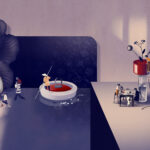Light, plasticine and humour: Stefano Colferai for “What’s in a Lamp?”

In the latest collaboration for the “What’s in a Lamp?” project, Stefano Colferai draws inspiration from VITE. Using an unconventional material like plasticine, he creates animated stop-motion scenes that playfully depict everyday life, illuminated by Foscarini lamps.
Milanese artist Stefano Colferai stands out as a versatile talent. Starting with graphic and digital illustration, he ventured into 3D modeling and then seamlessly delved into sculpture, embracing the rarely used medium of plasticine. His engaging and ironic characters and animations have captured attention globally, gaining recognition from publishers and magazines overseas, and expanding internationally the reach of his art.
In his series for Foscarini’s “What’s in a Lamp?” editorial project, Stefano Colferai explores the relationship between light, lamps, individuals, and the home—drawing a parallel with another Foscarini editorial project: VITE (by Foscarini and Gianluca Vassallo, more information on vite.foscarini.com), which has been a major inspiration for the artist. The result is an animated series in which Foscarini lamps seamlessly integrate into the daily life of a friendly plasticine character throughout the day, from morning breakfast to evening binge-watching.
In this exclusive interview, we explore Stefano Colferai’s creative world and dive into his collaboration with Foscarini. The artist shares his artistic journey, the choice of plasticine as a distinctive material, and shares insight on the crucial role of light in his art.
Tell us about yourself: did you always know you wanted to be an artist? What led you to sculpture?
Absolutely! I’ve always had the desire, will, and need to express my ideas through various mediums, constantly seeking what could best align with my imagination and bring me satisfaction. It has been a self-taught journey centered around creating characters, starting from drawing on paper to digital art and finally transitioning to sculpture.
Why did you choose to work with a material like plasticine? How did you learn to use it?
During a phase of stylistic exploration, I was drawn to the 3D world to add depth to the characters and illustrations I was creating (approximately ten years ago). As I delved into 3D and experimented with digital tools, I realized that my creative turning point could lead me towards a more artisanal direction, bringing me back to the genuine hands-on approach. I began working with plasticine and photographing it, following an intuition to use it as a material for my sculptures while staying true to my style from that era, simulating a real 3D effect.
What is your creative process? Do you have any rituals when creating your sculptures?
It’s very spontaneous; I rarely sketch ideas because I prefer to visualize and immediately shape an idea I’ve had with my hands. Perhaps my ritual is jotting down all my ideas on my phone’s notes to avoid letting them slip away, revisiting them when I can bring them to life. From that point on, it’s a continuous flow between sculpture, photography, animation, and post-production.
What role does light play in your art?
The role of light is fundamental: my works wouldn’t exist without photography! While there’s consistency in the lighting of my works, I’ve conducted extensive research over the years to find the best relationship between my subjects, set, surroundings, and lighting, attempting to construct a narrative through light. Communicating through photos and videos, the right light can significantly enhance a sculpted piece and frames arranged in sequence to create an animation, establishing the proper atmosphere and defining the body and character of each scene. Studying the light in every animation or still frame is one of the moments I invest the most time in, along with modeling.
How did the collaboration with Foscarini come about?
Certainly through a shared interest in crucial elements such as light, attention, an appreciation for form, and craftsmanship.
In this project, you’ve depicted domestic, familiar scenes where Foscarini lights and lamps accompany the main character, telling something about his personality, activating sensations and emotions that are easy to relate to. Can you tell us more about the inspiration behind this work?
I found Foscarini’s VITE project fascinating from the start, depicting the relationship between light/lamp, person, and home through photography. It was greatly inspiring for me to capture imperfections in the shots of these narratives where light is abundant, attempting to question how the relationship between a person and their home has changed over the years. Engaged in character design and stimulated by Foscarini’s project, I wanted to create my own character and let him live in various hypothetical settings, much like snapshots of lives. The character thus experiences his daily routine accompanied by the light and form of the lamps in different rooms, preserving the language that characterizes my artistic style with the same spontaneity as the VITE stories.
Are there objects that make you feel “at home” wherever you go?
Yes, and I’d include coffee cups, armchairs, wooden tables, lamps, picture frames and prints, maps, chests of drawers and shoe racks, record players and records, board games, and cards in the list. I could go on; the list is long!
Which scenes do you like the most in this series and why?
I’ve become fond of the painter’s scene, which I connect to my grandfather both in the set’s construction and in terms of light and ambiance. He always painted, replicating landscapes from postcards, photos of landscapes from newspapers, or memories of his places. The painting of Venice that the character creates is an Easter egg that references Foscarini’s origins but also reminds me a lot of him.
What are your sources of inspiration, and how do you cultivate your creativity?
I have several sources, and I try to keep them alive. I enjoy markets, where you can encounter people of all kinds, observe unexpected situations, smell aromas, and listen to different sounds, noises, and languages. I find inspiration in visiting galleries and attempting to understand artists I didn’t know, appreciating them or not. I’m inspired by anything involving manual effort and creativity, by people who surpass their limits and sporting achievements. I’m inspired by those who achieve their goals, but also by those who try with all their might and don’t succeed. I’m inspired by those who bring about change, and I find great inspiration in being in the shower. I’m inspired by traveling and stepping out of my comfort zone. I’m inspired by stories. There are many things that inspire me, and I try to cultivate my creativity as if all these things were lightbulbs to be turned on at the right moment!
What does creativity mean to you?
Making visible what has not yet been created.
Follow the project on the official Instagram channel @foscarinilamps


















